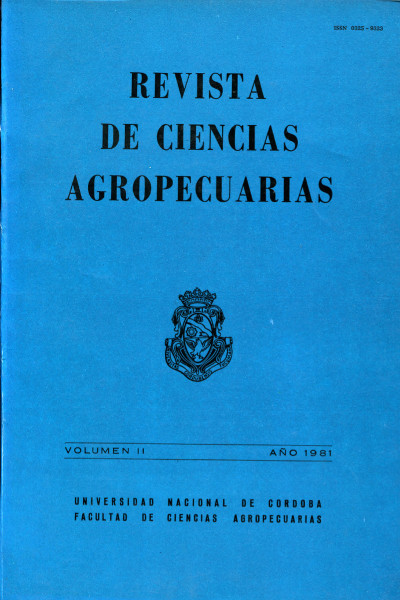The incidence of "Sorghum stalk rot (sorghum bicolor (l.) Moench" according to tillage and sowing practices
Main Article Content
Abstract
Downloads
Article Details
References
BURGOS, J. J. y A. D. VIDAL. 1951. Los climas de la República Argentina según la nueva clasificacin de Thornthwaite. Meteoros NQ I.
CARRERA, C. J. M. 1964. Podredumbre del tallo en sorgo granífero. IDIA, NQ 194: 46-48.
DOUPNIK, Jr. B.; M. G. BOOSALIS; G. WICKS and D. SMIKA. 1975. Ecofallow reduces stalk rot in grain Sorghum Phytopathology, NQ 65: 1021-1022.
FREZZI, M. J 1976. Podredumbre de la raíz y podredumbre basal del tallo (vuelco) del sorgo, en la provincia de Córdoba, Argentina. IDIA (en prensa).
KRUGER, W. and DUPLOY 1963. Control measures for stem and root. rot in maize Farming in South Afr.; No 39: 5-6.
MOSCHLER. W. W . and C. M. SHEAR. 1969. No-tillage corn. Agricultural Chemicals, NQ 24: 47-50.
PARKER, D. T. and W. C. BURROWS. 1959. Root and stalk rot in corn asi affected by fertilizer and tillage treatment. Agronomy journal, NQ 51: 414-417.
PRINCIPI, M. A. 1977. Comparación de sistemas de labranza y siembra para cereales de grano grueso compatibles con la conservación del suelo. Universidad Nacional de Río Cuarto ( inédito).
ROCCA DE SARASOLA. M. A. 1968 . Menor predisposición a la podredumbre basal y al vuelco en maíces cultivados con labranza mínima ( sin aporcadura). Rev. Inv. Agrop . Serie 5, vol. 5: 9-17.
SARASOLA, A. A., M. A. ROCCA DE SARASOLA y E. J. ALLIOT. 1971. Vuelco del maíz III. Predisposición determinada por compuestos químicos de la raíz o base del tallo y otros factores, modificados por sistemas de cultivos. Rev. Inv. Agrop., Serie 5, vol. 8: 15-43.
SARASOLA, A. A. y M. A. ROCCA DE SARASOLA. 1975. Fitopatología Curso Moderno. Ed. Hemisferio Sur, Buenos Aires.
WALL, J. S. y W. M. ROSS. 1975. Producción y usos del sorgo. Ed. Hemisferio Sur , Buenos Aires.
YARWOOD, C. E. 1968. Tillage and Plant Diseases. Bio Science No 18: 27-30.





